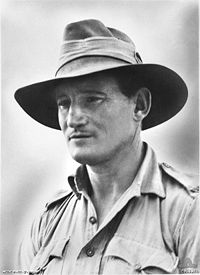| James Gordon | |
|---|---|
 Corporal James Gordon in October 1941 Corporal James Gordon in October 1941 | |
| Born | (1909-03-07)7 March 1909 Rockingham, Western Australia |
| Died | 24 July 1986(1986-07-24) (aged 77) Repatriation General Hospital, Hollywood, Western Australia |
| Allegiance | Australia |
| Service | Australian Army |
| Years of service | 1940–1968 |
| Rank | Warrant Officer Class II |
| Unit | 2/31st Battalion |
| Battles / wars | |
| Awards | Victoria Cross |
| Relations | William Gordon (father) Sir John Gordon (uncle) |
James Hannah Gordon, VC (7 March 1909 – 24 July 1986) was an Australian recipient of the Victoria Cross, the highest award for gallantry in the face of the enemy that can be awarded to British and Commonwealth forces. Gordon was one of 20 Australians to receive the award for their actions during the Second World War, receiving it for deeds he performed while fighting against the Vichy France during the Syria-Lebanon campaign, in which he personally bayonetted five Vichy French machine-gunners in the Battle of Jezzine.
Gordon later served against the Japanese in the New Guinea campaign and after the war became a soldier in the Australian Regular Army, serving until 1968. He died in 1986, at the age of 77.
Early life
Gordon was born in Rockingham, Western Australia, one of eight children born to William Beattie Gordon, a farmer who served as a state parliamentarian between 1901 and 1911, and his wife Harriet Ann Scott. Growing up on farming properties near Moora and in Gingin, Western Australia, after completing his schooling, Gordon undertook various laboring jobs including droving, farming and working on the goldfields.
Military career
On 26 April 1940, during the early stages of the Second World War, Gordon volunteered for overseas service, lying about his age to join the Australian Imperial Force; falsely giving his middle name as Heather. Shortly afterwards, he married Myrtle Troy at St Edmund's Church of England, Wembley Park, Perth, on 14 June 1940.
After a period of training, Gordon was sent to the Middle East in September 1940. He was later assigned to the 2/31st Battalion, an infantry unit formed in Queensland and Victoria, which was part of the 7th Australian Division, in February 1941. In June–July 1941, the unit was engaged in the Syria-Lebanon campaign against the Vichy French. During the Battle of Jezzine, on 10 July 1941, Gordon's company was "...held up by intense machine-gun and grenade fire from Vichy French forces, but on his own initiative, he crept forward alone and succeeded in getting close to the machine-gun post. He then charged it and killed the four machine-gunners with his bayonet. His action demoralised the enemy in this sector and the company advanced and took the position." Gordon was subsequently awarded the Victoria Cross for this action.
On 12 July 1942, a plaque in his honour was unveiled in front of the Gingin Post Office; it was later moved to the town's war memorial. Later that year a portrait of Jim Gordon painted in 1941 by artist William Dargie won the 1942 Archibald Prize, Australia's most famous portrait prize.
Gordon returned to Australia in March 1942, now holding the rank of corporal. While the 2/31st Battalion was soon deployed to Papua, a bout of malaria prevented Gordon from joining it until November 1942. He was promoted to sergeant in July 1943. After seeing further action during the capture of Lae and the subsequent advance through the Markham and Ramu Valleys in New Guinea, he returned to Australia in January 1944. He was hospitalised due to malaria again, and was later reassigned to administrative duties. He remained in the Army until 17 February 1947.
After discharge, Gordon briefly worked for the State Electricity Commission, before rejoining the army as a regular soldier on 2 December 1947, achieving the rank of Warrant Officer Class II in 1950. He continued service until 1 August 1968 when he retired; after this, he was employed at Campbell Barracks (Western Australia), Swanbourne, as a groundsman until 1975.
Later life
Gordon died on 19 July 1986 at the Repatriation General Hospital, Hollywood. After being cremated, he received full military honours. The Jim Gordon Ward at the former Repatriation General Hospital has been named in his honour. His wife, Myrtle, and one son survived him.
Notes
- ^ Horner 2007, pp. 448–449.
- "No. 35325". The London Gazette (Supplement). 24 October 1941. p. 6237.
- "James Gordon V.C." Monument Australia. Retrieved 18 June 2015.
- "Our Hospital: A History of Caring". Hollywood Private Hospital. Archived from the original on 19 December 2013. Retrieved 18 June 2015.
References
- Horner, Jolyon (2007). "Gordon, James Hannah (Jim) (1907–1986)". Australian Dictionary of Biography. Vol. 17. Canberra: National Centre of Biography, Australian National University. pp. 448–449. ISBN 978-0-522-84459-7. ISSN 1833-7538. OCLC 70677943.
- Laffin, John (2002) . Forever Forward: The History of the 2/31st Australian Infantry Battalion, 2nd AIF, 1940–45. Loftus, Australia: Australian Military History Publications. ISBN 1-876439-33-5.
- Udell, Hazel (1980). A History of Gingin: 1830 to 1960. Gingin, Western Australia. ISBN 0-9596765-1-1.
External links
- Private J.H. Gordon in The Art of War exhibition at the UK National Archives
- 1942 Archibald Prize winner, William Dargie's 1941 portrait of Jim Gordon.
- James Heather Gordon, Who's Who in Australia, p 356, 1980 Edition, compiled and edited by W.J. Draper, Melbourne, Australia
- Transcript of recommendation for VC
-
 Dargie painting Gordon's portrait
Dargie painting Gordon's portrait
-
 Gordon and the completed picture
Gordon and the completed picture
-
 Right: Sgt Jim Gordon, VC of Gin Gin, WA. 1943-10-01. New Guinea. Lae
Right: Sgt Jim Gordon, VC of Gin Gin, WA. 1943-10-01. New Guinea. Lae